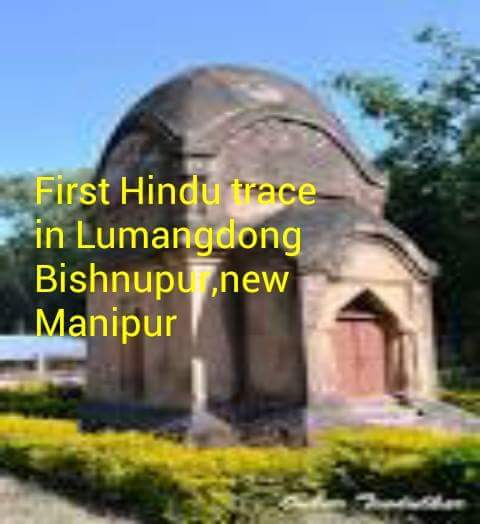
মধ্যযুগে নির্মিত একমাত্র বিষ্ণু মন্দির উত্তর পূর্ব ভারতের মৈত্রাবাকে,বর্তমান মনিপুর রাজ্যের বিষাণপুর অঞলে।বিষাণপুর বা বিষ্ণুপুরের ঐতিহাসিক নাম "লামাংডং"।এই অঞলে বৈষ্ণব ধর্ম রক্ষনাবেক্ষনর জন্য নির্মান করেছিল প্রবাসী বৈষ্ণবগন।মধ্যযুগে বিষ্ণুপুরের রাজাদের বৈষ্ণব ধর্ম প্রবর্তন ও প্রসারের দিক থেকে লক্ষনীয় এই ভুখন্ডে বৈষ্ণবগনের প্রত্যাবর্তন।
মনিপুরের নুতন নামাকরন হয় ১৭৭৪ ইংরেজীতে নাগারাজ(বর্তমান মৈতেয় বা মনিপুরী নামে চিন্হিত) চিং থং (নামাকরন-ভাগ্যচন্দ্র) হিন্দু ধর্মে দীক্ষিত হওয়ার পর।লামাংডঙে এই মন্দিরের তৈরী আনুমানিক ৪৫০ বৎসর আগে সেখানের ইতিহাস মত এবং এই মন্দিরটি কোন রাষ্ট্রীয় বা রাজ পৃষ্ঠপোষকতা ব্যতীত নির্মান হয় যা নিয়ে ইতিহাসবিদগন ভিন্নমত পোষন করে আচছে।এই মন্দির স্থাপনার পর এই অঞলের নামাকরন হয় "বিষ্ণুপুর"।এটাই প্রথম হিন্দু উপস্থিতির চিন্হ এই প্রদেশে।মহাভারতের মনিপুর বর্তমান উড়িষ্যাতে।
বিষ্ণুপুর(মল্ল রাজাদের রাজধানী) সুপ্রচলিত নামাকরন আজও ভারতের প:বঙ্গ রাজ্যে প্রসিদ্ধ।বর্তমান উ:পূ: ভারতের মনিপুরে আর্যভাষীদের উপস্থিতির বহুকাল পরে আর্য শব্দগুলি নিয়ে কিছু অঞলের নামাকরন ধীরে ধীরে শুরু হয়।১৮ ছেন্চুরীতে মনিপুরের রাজারা হিন্দুধর্মে দীক্ষিত হওয়ার পর এই ঐতিহাসিক মৈত্রাবাক বা বর্তমান মনিপুরে বংলা লিপির প্রচলন হয় পুথি অনুবাদের তাগিদে।বর্তমানে মনিপুরে তাদের প্রাচীন অক্ষর (অনেকটা দেখতে চীনা হরফের মত) পুনর্বিন্যাসের কাজ প্রায় সমাপ্ত।
Manipura Of Mahabharata
Arjuna's Pilgrimage. Readers are requested to read it first.
This article describes the long pilgrimage journey of Arjuna from Indraprastha to various places in ancient Indian peninsula. In this journey Arjuna is mentioned as travelling to a city named Manipura. My analysis in this article shows that this city lied in Kalinga territories (coastal Orissa).
The gateway into Kalinga
Mahendragiri
The city of Manipura
Manipura River
Manipura Village
Manikapatana
Dakshina Kalinga
Princess Chitrangada
Manipura and Kalinga
The Southern Ocean
The Crocodiles
The Apsaras
The name Saubhadra
References
The gateway into Kalinga
After visiting the confluence of Nanda and Aparananda rivers, Arjuna proceeded along the river Ganga to see all the sacred places in the country of Vanga (Bengal and also ventured into Kalinga (coastal-Orissa) that lied to the south of Vanga. However the Brahmanas following him stopped at the gate of the kingdom of Kalinga. Some Puranas mention that the (northern) gate of the kingdom of Kalinga was the river Vaitarani (River_Baitarani). There is a myth that that river is the gateway towards the underworld or hell ruled by Yama, the god of the underworld, as southern direction is considered as the direction of Yama and of the underworld. This could be the reason why Brahmanas bid farewell to Arjuna and desisted from proceeding any further. Another reason is that the territories beyond that (to the south of Vaitarani) where Vedic religion was sparingly followed, was not well known for the travelers from Kuru-Panchala kingdoms who followed the Vedic religion. Hence the fear of unknown territories might have prompted the Brahmanas to stop there.
The map shows the Vaitarani River, the Manipura Village, the Manipura City, Manipura territories lying as an independent territory within Kalinga territories , the territories of other kingdoms, Mahendra Mountains, the location of the five sacred waters in the southern ocean (south of Puri), the location of places named Gokarna near Kalinga.
Mahendragiri
Arjuna continued further and probably crossing Vaitarani, reached the ocean accompanied by his attendants. He traveled along the coat-line, through the country of the Kalingas. He saw Mahendra mountains. During the Mahabharata-era, the whole of the mountain range (Eastern_Ghats) that lied to the west of Kalinga (coastal-Orissa) was known as Mahendra Mountains. It was the natural western boarder for Kalinga, which had sea for its eastern boarder. A mountain peak in Eastern Ghats, in southern-Orissa is still known as Mahendra-giri, meaning the Mahendra mountain(Coordinates: 18°58′28″N 84°22′05″E). The Mahendra mountain range is related to sage Parasurama who spend his last days of ascetic life here. Mahendragiri, means the great and best mountain or //the mountain named after the great Indra (the king of the Devas).
The city of Manipura
Mani-pura means, (Mani:- name of a precious-gem; Pura:- city) the city of Mani, the city of gems, the jewl-city or the city named after a precious-stone. It can also be called Manipuri since the word Pura or Puri both means, the city. The location of Manipura is highly debated. Often the north-eastern state of India, viz. Manipur is considered as the location of Manipura mentioned in this passage of Mahabharata. This location is problematic because Manipura was a city. It cannot be a vast region as large as a state like Manipur. Secondly, the geography mentioned in Mahabharata clearly indicate that it is within or close to the Kalinga territory (i.e. coastal-Orissa) and near to the sea. The city of Manipura thus lied in the valley of Mahendra mountain ranges and close to sea-shore. It is possible that people in the north-eastern state of Manipura where originally migrants from this Kalinga city named Manipura. The names like Brahmini river, Brahmagiri, Brahmapur (Behrampur) in this locality indicates that the people of Brhamaputra river and the modern nation Burma (a corruption of the word Brahma) too were originally from this region. People of Manipura city in Kalinga might have migrated along with these Brahma tribe to reach the Manipur state, that borders Burma.
There is a village named Manipura, a river named Manipura and an ancient-port city named Manikapatana in Kendrapara district of Orissa.
Manipura River
The Manipura river is a dis-tributary of Brahmani_River in Orissa. As Brahmini river joins Baitarani, it splits into two dis-tributaries; one joins Baitarani as Brahmini and the other joins the sea as Manipura river. Manipura river joins the sea forming a natural-harbor, that could serve as the sea-port of Manipura. One the northern bank of this Manipura river is a place named Rajhagarh. The place-name literally means the house of the king. This could be where the palace of the king of Manipura stood. Now it is inside the Bhitarkanika_National_Park, where Saltwater_CrocodiNew Paragraph